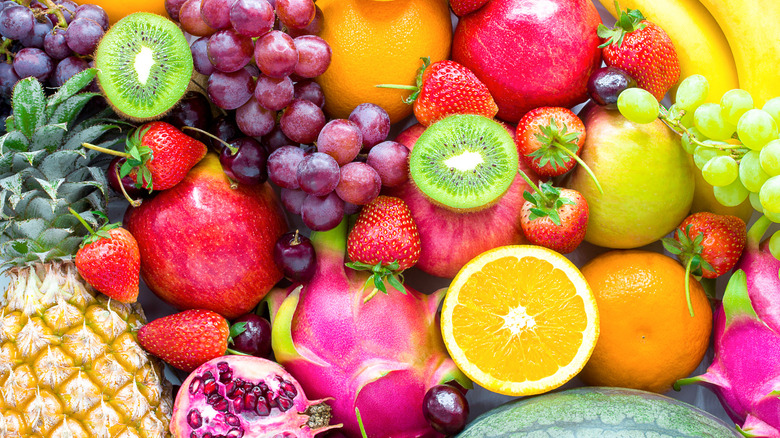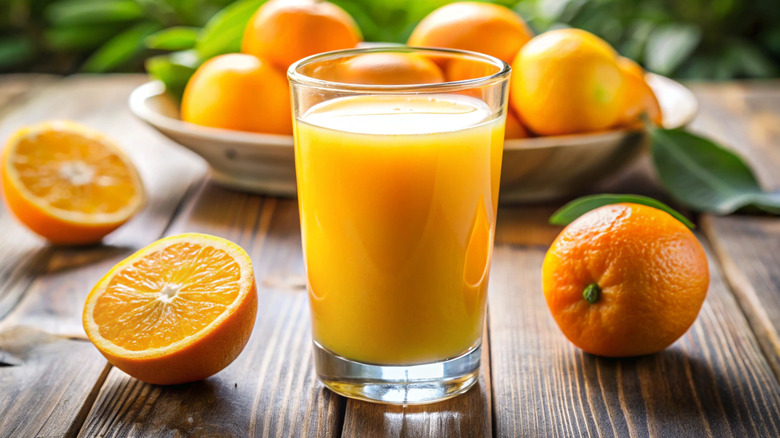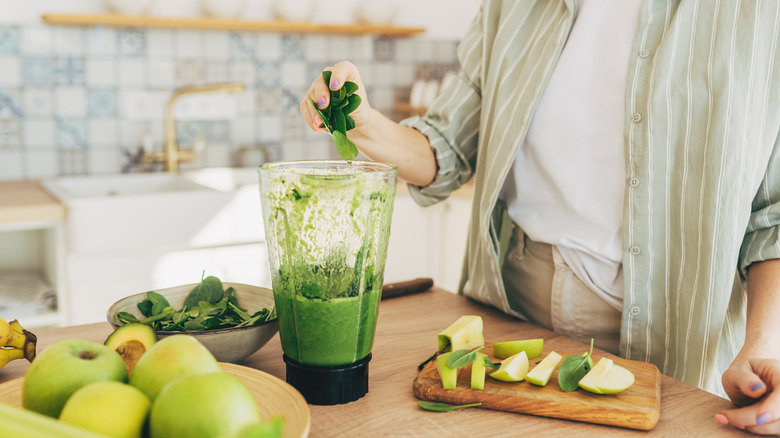Fruit Smoothies Vs Juice: Which Is Best For Hydration?
Smoothies and juices are popular, customizable beverages commonly made using a variety of fresh or frozen fruit or vegetables. While they share the main core ingredients, their primary difference is how they're processed — which affects both their nutritional content and their hydrating power. Juicing works by separating the liquid from the pulp and fiber of fresh produce. On the other hand, blending incorporates the whole fruit or vegetable, combining them in a blender with another liquid like water, milk, fruit juice, or even kombucha as an alternative to make a delicious blend.
Given these contrasting preparation processes of similar ingredients, it raises the question of which method is best for hydration. To find out, Food Republic spoke with Adam Gilbert — certified nutrition coach and founder and chief body tutor of MyBodyTutor. According to Gilbert, "From a hydration standpoint specifically, juices can be effective at contributing to your daily fluid needs due to the high water content of the fruits and vegetables used."
While juice is the superior option if you're looking just for liquid, Gilbert also noted that there are ways you can tactically boost the water content of your smoothies to put them on par with juices. "The beauty of smoothies is that you can turn them into hydration powerhouses with the right ingredients," Gilbert told us. So if you're a dedicated smoothie fan, there's no need to worry — there are still many ways you can make them amazing for hydration while benefiting from the fiber and nutrients that smoothies naturally retain.
What makes juices so hydrating?
Whether you're using a cheesecloth, centrifuge, or a citrus reamer, juicing fruits and vegetables is a super-easy way to create beverages highly concentrated in water content and nutrients. Adam Gilbert explained, "Juices can help you meet your daily water intake, which is about 91-125 ounces for adults."
If your goal is maximum hydration, choose fruits and veggies with a water content of 90% or higher. Gilbert noted, "Many fruits and vegetables used in juicing, such as watermelon, celery, oranges, and spinach, have high water content that supports hydration." If you're looking to incorporate hydrating ingredients into your juices, try making a spicy green juice that uses water-rich celery and cucumbers.
Gilbert also highlighted another important benefit of juices over smoothies: "One good thing to note also is the fact that juice provides high amounts of concentrated nutrients." So, while juices are super hydrating, they also contribute to your five-a-day by delivering a high amount of easily absorbed essential nutrients. Compared to smoothies, juices are high in electrolytes — like potassium and magnesium — which are integral for regulating the body's fluid balance to enable water retention and absorption. If you're looking for fruits and veggies high in electrolytes for your next juice, cherries, watermelon, and oranges are excellent (and delicious) options.
How can you make your smoothies more hydrating?
Although smoothies are lower in water and higher in non-hydrating elements like fiber, Adam Gilbert noted they can still be a highly quenching option — if made with the right ingredients.
For a hydrating smoothie, Gilbert recommended, "Start with coconut water as your liquid base instead of regular water as it's naturally rich in potassium and other electrolytes. Add fruits like watermelon, which is 92% water, or oranges for Vitamin C and additional electrolytes." For vegetables, Gilbert added, "cucumber, celery, and even spinach add both water content and minerals without affecting taste when blended with fruits." By adding ingredients high in water and electrolytes, you'll boost the hydrating power of your smoothies –- plus the fiber aids digestion and blood sugar regulation, which isn't present in juices.
Smoothies are more versatile than juices, allowing you to put a great variety of ingredients in the blender. This means you can customize your blend to enhance its hydrating effects. For example, try blending your ingredients with homemade electrolyte water. Gilbert also recommended, "A pinch of high-quality sea salt can boost sodium levels if you've been sweating," which supports fluid balance in the body. And if you're worried that salt might make your smoothie too salty, it actually does the opposite.
"Chia seeds are fantastic because they absorb water and create a gel-like consistency that helps your body retain fluids longer," he added. So, ingredients that support water retention can take your smoothie's hydrating potential even further.



